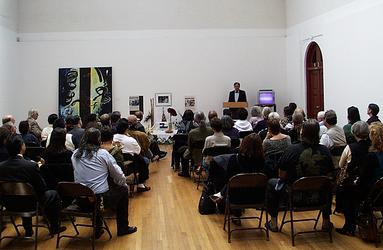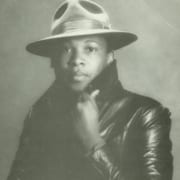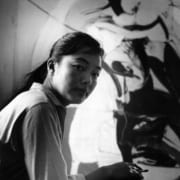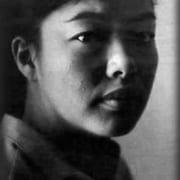Clarity by Moira Roth
CLARITY
By Moira Roth
Bernice Bing was a dearly loved friend of mine, and I knew her very well for the last ten years of her life.
I first met her at an extravagant sunny afternoon rooftop party to celebrate Jay de Feo’s 60th birthday in Jay’s Oakland studio in March of 1989.
In this afternoon of bright sunlight, and conversations and toasts among old friends–I saw Bernice in one of her many worlds: a Bay Area art scene that included Joan Brown, Bill Wiley, Robert Hudson, Leo Vallidor and Cornella Schulz–colleagues in her 1961 MA class at the SF Art Institute.
At the party I told Bernice that Flo Wong and Betty Kano were planning an organization of local Asian American women artists.
Suddenly it felt as if Jay de Feo’s party scene had disappeared–Bernice started to talk with me as if we knew one another well and were alone. For that is what she had been in some ways–alone. What had been missing from her rich life in Philo, where she had moved in 1985, was a connection with Asian American artists.
She was so excited to hear of the collective stirrings among Asian American women artists in the Bay Area and wanted to make immediate contact with them.
In the meetings and retreats of the Asian American Women Artists Association, I saw Bernice speak specifically as a Chinese American woman artist. At these AAWAA meetings, I was always struck by her sweet generosity toward the other women, and her deep pleasure in contributing to the construction of a present community and of an Asian American art history.
In 1991, Diane Tani and I worked closely with Bernice to create a Visibility Press catalogue of her work, which included a long chronology, for her one-person exhibition at the South of Market Cultural Center. Our research and the exhibition’s actual site made me acutely appreciate yet another setting of Bernice’s–a Bay Area activist world, in which she played a central role in the 1970s and early 1980s in the history of the Neighborhood Arts program and the creation and early running of the South of Market Cultural Center.
Over the years, I increasingly sensed the multiple realms in which Bernice lived–she lived, of course, as a practicing artist until the very end of her life. She lived as a lesbian, and as a Buddhist. She lived as a gardener, and a voracious reader. She lived for several years sick, and surrounded by a devoted group of friends.
Among her close friends were Hung Liu, Flo Oy Wong and myself, and the three of us, together with Hung’s son, L.C., and Flo’s husband, Ed, spent an evening with her some three weeks before she died.
I keep a diary so here–a little edited–are my last entries about Bernice.
Wednesday, July 29,1998
My first dinner party tonight after returning from Asia. Bernice drove down from Philo and will be staying the night–she seems surprisingly well, is cutting down on her medication, has gone back to oil painting, and more and more is drawn to Tibetan Buddhism. Each morning she does a mantra.
The evening was full of animated talk, a lot of it around the Cultural Revolution. Hung Liu is leaving for China again on Sunday to meet with her classmates–the ones she met while we were in Beijing at her high school’s 30-year anniversary–all of whom were in the Cultural Revolution shortly after they graduated. We talked about The Red Guard, who were so deliberately and proudly uneducated, and Bernice said that when the Cultural Revolution was over they had no role–many became street cleaners. Bernice had been in China for three months in the mid 1980s–and she often talks of China, of her memories of this visit, and of her readings in Chinese history and culture. Hung’s son, who sat next to her that night, had just returned from Beijing, and he and she talked about China at length during the long dinner.
All in all an intense evening of conversation among a family of friends.
Thursday, July 30, 1998
Talk with Bernice over tea this morning–she is more and more deeply drawn to Tibetan Buddhism, up until now said she had been involved with a more outer-directed form of Buddhism, with a focus on peace and social justice. This Tibetan version is more inner-directed–she uses the word “clarity” to apply both to its practice and the goal she had set herself for her new paintings.
She showed me photographs of a Tibetan monastery in Northern California–its lavish gardens are swept everyday–where she had just attended a workshop and had been profoundly affected by it.
We also talked about death and old age, which we often do–she is sixty-two, and I am sixty-five.
Wednesday, September 16, 1998
Have just returned from England today. Messages from both Flo and Hung, Bernice has died in her sleep, very peacefully on August 18.
I am stunned.
I remember her last visit at the end of July–seven weeks ago.
I had brought her back a purple-and-black silk scarf from Burma as a present for that dinner party. She loved it. She always greatly appreciated presents, and was a great present-giver herself. She would always write thank you cards for dinners, and little offhand notes.
I remember that day of her last visit she had brought me gladioli from her garden–striking unusual colors, a mauve among them–wrapped in rice paper with calligraphy on it, something she had drawn quickly before leaving Philo.
I remember another time too, finding flowers from her–bright yellow daisies–on my doorstep, again beautifully wrapped, this time in gold and red Chinese paper.
I remember when we talked that last time at my house that she had spoken of clarity–in relationship to her Buddhism and art–but what I was most struck by was the immense clarity in her own presence.
Clarity
I find it consoling that she herself was possessed by such clarity just before she died.
I remember the clarity of her face–broad and clear.
I remember the clarity of her smile.
I remember the clarity of her art.
Bernice Bing Memorial
San Francisco Art Institute, 1998
Clarity: Bernice Bing
by Moira Roth




 Photo ©Grover Sales
Photo ©Grover Sales